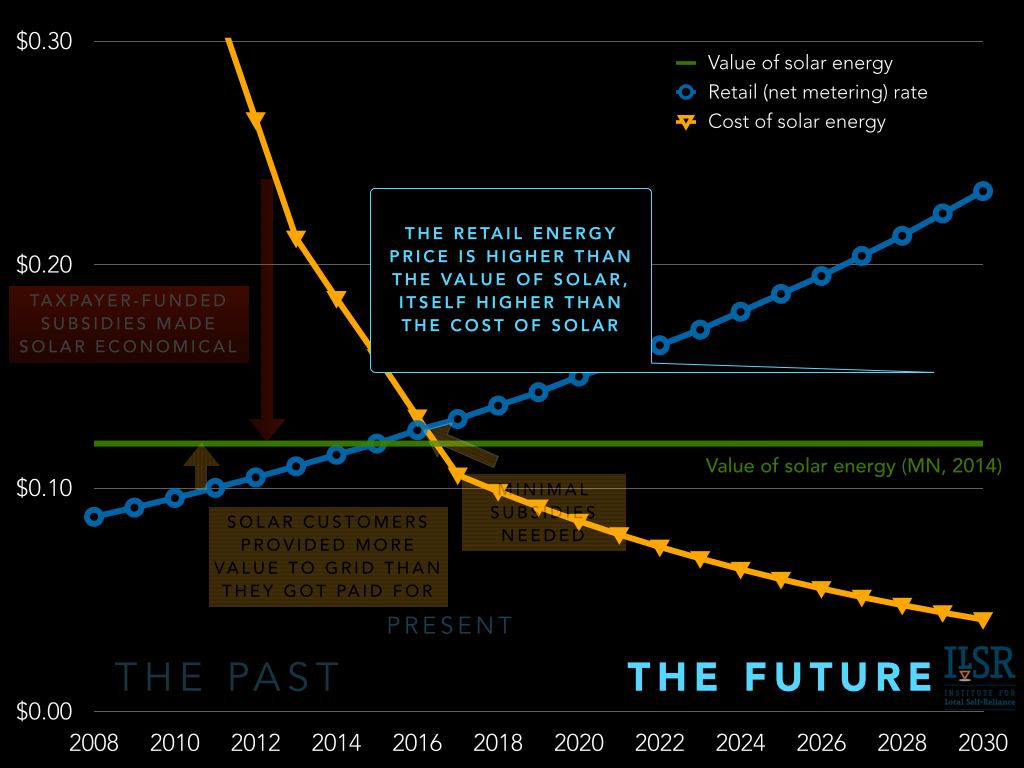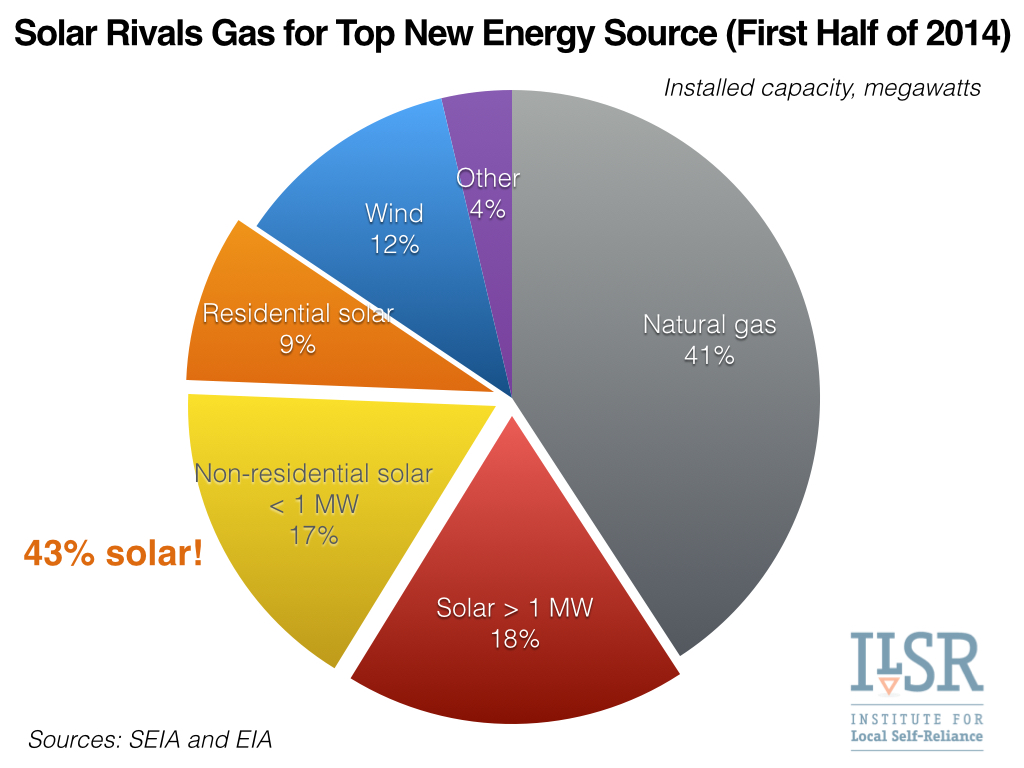Earlier this year, Minnesota became the first state to formalize dozens of studies by adopting a “value of solar” formula that would fundamentally change the relationship between solar energy producers and their utility. It’s designed to have the utility accurately compensate solar energy producers for the value of solar electricity to the utility, its customers, and society. And by separating solar production from consumption, it also ensures that all electric customers are paying for their share of the electric grid. So far, no Minnesota utility has adopted the voluntary formula.
But do we really want utilities to adopt value of solar? (share your thoughts in the comments)
The Case for Value Of Solar
In an extended post in May 2014, I made a strong case for the economic rationale behind the value of solar (as compared to net metering). I also highlighted the political consequences of ignoring the increasing gap between the cost and value of solar, and between those figures and the retail electricity price. That issue was captured in this slide from my Future of Solar presentation:
The issues raised in that post and the above chart remain true because net metering is an accounting policy, not an engineering one. It allows customers to pay the net between their solar production and on-site electricity use, even though much of the energy off their solar panels will spill back onto the grid. So even though much of the electricity produced doesn’t actually offset on-site use (because, for example, people use electricity at 9pm when solar production is virtually nil), customers with solar arrays reduce their bill as though they do offset their energy use.
Utilities suggest this the above chart illustrates a big problem, but their solution – big fixed charges on electric bills – hardly encourages any socially desirable behavior. Rather it’s a great ploy to defend a business model of a monopoly utility that’s rapidly going out of date in an era of smart grids and distributed renewable energy.
What Change to Choose?
We have better options than cementing a utility’s grid monopoly, but all options aren’t equal.
Alternative 1 – Value of Solar
Value of solar is a compromise position. It says that compensation should follow the electrons, with producers paid for what they produce and consumers paying for what they use. When well designed, value of solar is an economist’s dream: transparently setting prices on the basis of all necessary costs and benefits.
But what if we believe that customers have a right to generate their own power and to offset their own energy consumption, and should not be compelled to sell their output to utilities? Or what if we believe (as discussed more below) that power supplied at the retail level should be compensated at the retail price? Or what if we feel like it’s the utility’s job to come up with a palatable alternative to net metering and not the advocates of a distributed renewable energy future?
Alternative 2 – Net Metering + Value of Solar
Another option would be to combine the best of both policies, using net metering to credit customers up to their monthly bill total (allowing them to zero out their bill), and paying them the value of solar price (instead of a generic avoided cost or the retail electricity price) for net excess generation. This is a pretty small tweak, since many net metering customers don’t actually produce more than they use, but it would respond to the criticism that solar produced for the grid be paid a price commensurate with its grid value, not the delivered retail electricity price.
This policy could also be applied cumulatively. If the solar energy produced by all customers on a local distribution feeder stays local, it’s paid at the net metering rate. When solar energy spills back onto the larger grid system (a wholesale rather than retail transaction), any excess generation (spillover) would be paid at the value of solar price.
Alternative 3 – Actual On-Site Production + Value of Solar
Alternatively, we could require that solar energy produced on-site only reduces the electricity bill if it’s used on-site. Thus, if a customer wanted to “net meter” they would have to store noon-time energy in excess of their on-site use (e.g. in a battery) to use later in the day. Excess power sent to the grid would be compensated at the value of solar price.
This is a fundamental change that’s also economically inefficient. We have an electric grid with a multitude of energy sources, and often plenty of nearby demand that a rooftop solar array can serve. Why balkanize the grid with millions of solar + energy storage systems unnecessarily?
Alternative None – Stick with Net Metering
A solar producer whose energy spills onto the grid is replacing a utility’s retail delivered power to nearby load. And if that’s the case, then why shouldn’t that customer be paid the same price the utility is paid – the retail rate – for every single kilowatt-hour put onto the grid?
Are we seeking alternatives simply because the utility is losing market share? Is it because utilities don’t understand the value of the trade––solar energy instead of cash for service?
The Issue of ‘Fair Share’
The crux of all these policy options is the notion of whether solar energy producers (who rely on the electric grid for energy at night or when it’s cloudy) are similarly supporting the maintenance of the electricity system as customers that don’t net meter. Given utility “solutions” that include taxes/fees on solar producers and fixed charges, it’s clear that they believe a fair share has to be a set-aside––if you don’t send the utility some money every month, it’s not “fair.”
But numerous studies show that solar energy producers provide something of value to the utility, often in excess of their compensation. Even if a solar producer pays zero for electricity bill, the utility has received something of value, just not cash.
Nor is there anything holy about using fixed charges to cover fixed costs. There’s no cover charge at Starbucks, but there are enormous fixed costs in keeping locations open, lit, and operational. What makes a utility system any different? (and if utilities have major rate design problems, why is it only the advent of widespread solar adoption that’s motivating a change?)
Net Metering: a Proxy in the Battle for a Democratic Energy Future
Utilities rightly see the end of an era, with technological change revolutionizing their business. Value of solar (if properly calculated) is a terrific, economically efficient policy for addressing customer and utility concerns about fair compensation.
On the other hand, it’s a drop in the sea change happening to the electricity business model.
There’s $364 billion in revenue from electricity sales in the U.S. every year, and much of that is up for grabs due to the opportunity from widespread, distributed renewable energy. Residential and commercial rooftop solar alone accounts for 17% of new power plant capacity in the first three-quarters of 2014; the entire paradigm of the electricity system is shifting.
The question to ask is not whether value of solar or net metering are the best policy for compensating on-site solar energy producers, but which policy will lead to a better energy future. Which will unlock more of the potential for communities to capture their energy dollars and empower individuals and communities to be their own power company?
On the issue of economic purity, value of solar makes a lot of sense. But it also cements the notion that all people are utility customers, even if they are producing power to sell to the utility. Net metering may be imperfect, but in allowing people to offset their energy use with their production, it supports a philosophy of energy self-reliance. Today’s transformation of the electricity system could accommodate utility market power or upend it. And the policy we choose for solar compensation––value of solar or net metering or something else––will play a role in that outcome.
Photo credit: Mike Spasoff
This article originally posted at ilsr.org. For timely updates, follow John Farrell on Twitter or get the Democratic Energy weekly update.





